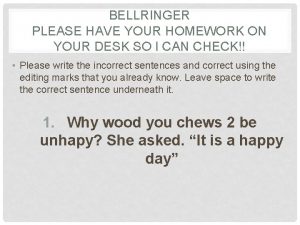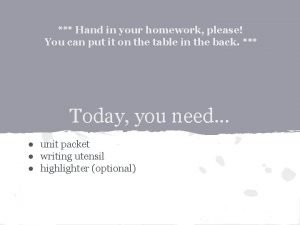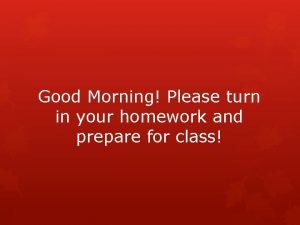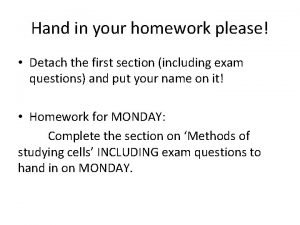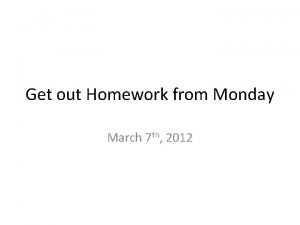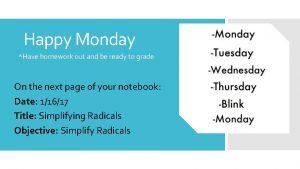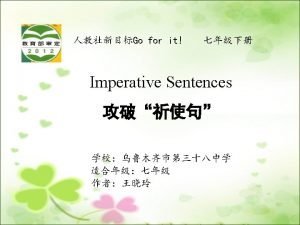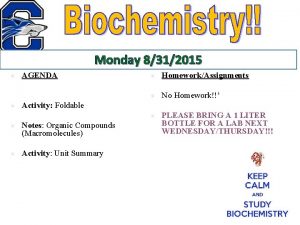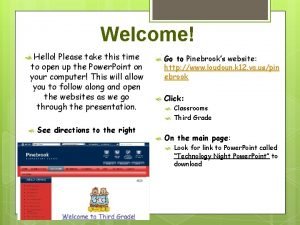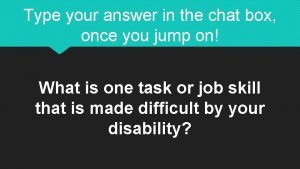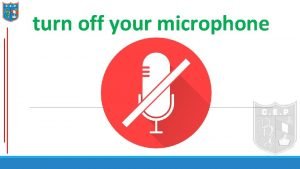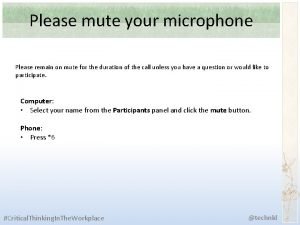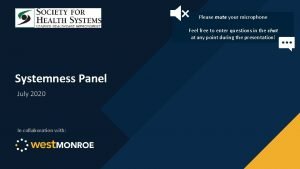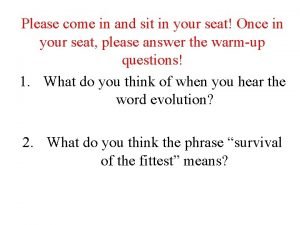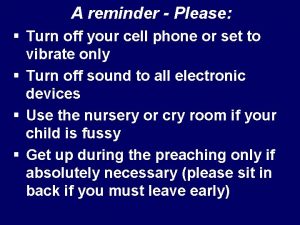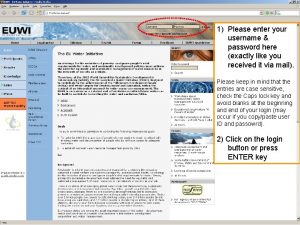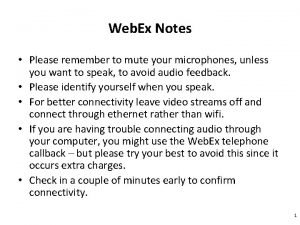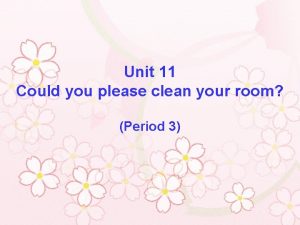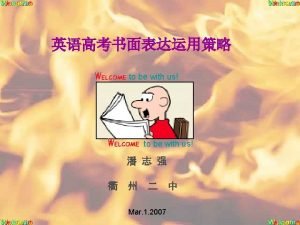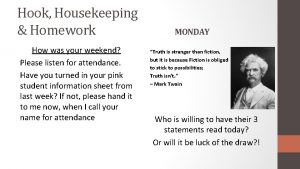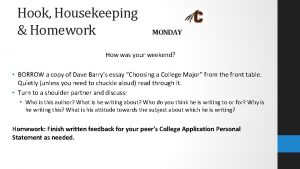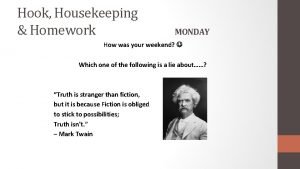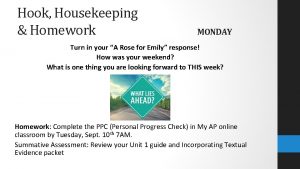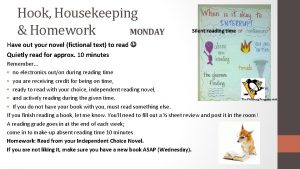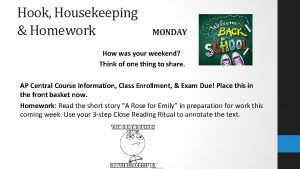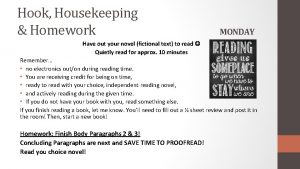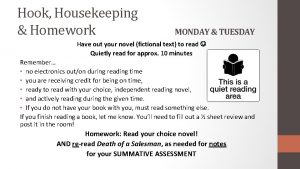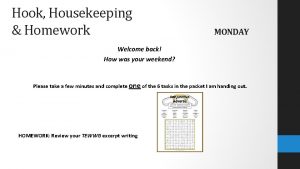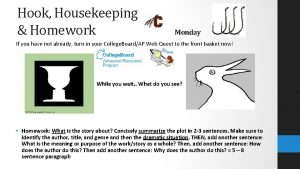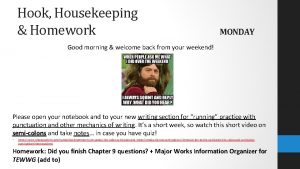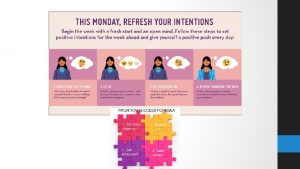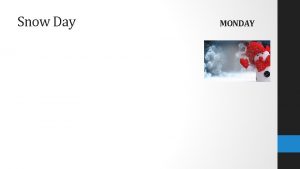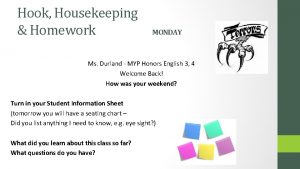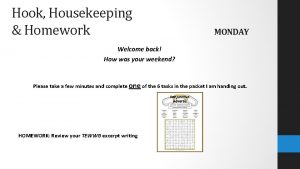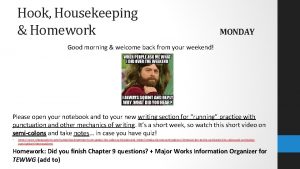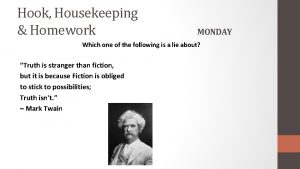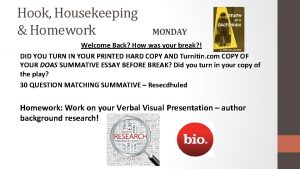Hook Housekeeping Homework MONDAY Please open up your




































- Slides: 36

Hook, Housekeeping & Homework MONDAY Please open up your notebook to your reflective writing space, draw a line, date and quietly respond to the following: How was your weekend? What did you do? What is one positive memory, accomplishment, outcome, appreciation? What are you looking forward to or want to accomplish this week? Why are you looking forward to it? HMWK: Review your Poetry handouts and practice sheets for your assessment on Wednesday + My AP On-line PPC Unit 2 Poetry • 18 questions opens Friday AM, due Wednesday, 7: 30 AM + Read Chapters 16 -20 TEWWG by Wednesday, Oct. 2 nd

Past, Present, Future MONDAY Unit 2: Poetry 1 = Prose vs. Poetry + “Out, Out—” by Robert Frost (character, setting, POV, structure) + “Digging” by Seamus Heaney (character, setting, POV, structure) + How to Find Your Way: TPCASTT - the big picture + “I am Offering This Poem” by Jimmy Santiago Baca (structure) +“Theme for English B” by Langston Hughes (contrasts) + “The Fish” by Elizabeth Bishop (function of words & phrases) + Figurative Language + “Terminus” by Emerson (Claim) Quiz Chapters 7 -15 TEWWG Unit 2: Poetry 1 • Peer Models, Self-Assessments, & Outlining Ideas • “The Sun Rising” by Donne (Claim + Line of Reasoning) – if time allows Unit 2: Poetry 1 • Peer Models, Self-Assessments, & Outlining Ideas • Summative on Wednesday, October 2 nd • HMWK: My AP On-line PPC Unit 2 Poetry • 18 questions opens Friday AM, due Wednesday, 7: 30 AM +Read Chapters 16 -20 TEWWG by Wednesday, Oct. 2 nd

Activity: Develop & Apply Purpose: to identify the components of a Thesis (defensible claim) followed by a Point (topic sentence), Illustration (textual evidence) and Explanation/Elaboration (commentary), including a concluding sentence Tasks: 1. Review the short fiction selection from Middlemarch – note prompt etc. 2. Examine 3 different body paragraph that follow PIEE – note the Scoring Guidelines (see next) base don the directions (see next) + AP® English Literature Scoring Rubric for Free-Response Question 2 3. Revisit your own 4. FIRST, did you…? 1. 2. 3. 4. 5. Read annotate the prompt Briefly/quickly familiarize yourself with the text (NO vocab. look up) Read closely and annotate the text • details based on the prompt – patterns – new understanding Write a rough thesis / claim Annotate your annotations – star, number, arrow an outline what details you will use in what order to prove your claim

Activity: Summative Assessment 1. Write a defensible claim as if you were being graded on a full 40 -minute essay (indent) 2. Follow that claim with one well-organized paragraph that supports your claim and addresses your first line of reasoning (indent) 3. Start with a topic sentence that makes a point about your claim (1 st reason) 4. Follow this with textual evidence • Incorporate this evidence seamlessly and punctuate correctly – USE (paragraph numbers – whoops line numbers!) here since they are #ed 5. Then, explain and elaborate (how does this evidence support your point). 6. You must include at least one more piece of textual evidence and explanation/elaboration. 7. Finally, include a concluding sentence that ties all of your ideas in this paragraph together.

SCORING DOMAIN – THESIS What is the complex relationship between the husband the wife? How does narrative perspective, detail, or other literary devices support/convey this relationship? Exemplary/Proficient • Responds to the prompt with a defensible thesis that presents an interpretation • Responds to the prompt rather than restating or rephrasing the prompt • Clearly articulates a position on or defensible interpretation in response to the prompt • Details an accurate line of reasoning Satisfactory/Emerging • Responds to the prompt with a defensible thesis that presents an interpretation • Responds to the prompt rather than restating or rephrasing the prompt • May provide a line of reasoning Unsatisfactory • There is no defensible thesis • The intended thesis only restates the prompt • The intended thesis provides a summary of the issue with no apparent/coherent claim; the text or features of it are described rather than making a defensible claim • There is a thesis, but it does not respond to the prompt; a generalized comment about the text is made

Start with a topic sentence that makes a point about your claim (1 st reason) Topic Sentence • Provides an analytical topic sentence that supports a line of reasoning from thesis • Provides a topic sentence that connects to the topic • Does not provides a topic sentence

1. SCORING DOMAIN – EVIDENCE Follow this with textual evidence Incorporate this evidence seamlessly and punctuate correctly – USE (paragraph numbers – whoops line numbers!) here since they are #ed You must include at least one more piece of textual evidence and explanation/elaboration. Exemplary/Proficient • Makes textual references (direct quotes or paraphrases) that are most relevant to thesis. • Varied evidence • 2 -3 references Satisfactory/Emerging • Makes textual references (direct quotes or paraphrases) that are mostly relevant to thesis; may provide some non-specific references to or summaries of the text or vaguely • Mostly varied evidence • 1 -2 references Unsatisfactory • Summarizes the text without specific textual references to a thesis • Repeats provided information or textual evidence • 1 reference • Provides examples that are generally irrelevant and/or incoherent. • Provides references to the text that are vaguely relevant

COMENTARY - Explanation/Elaboration Then, explain and elaborate (how does this evidence support your point). • Provides well-developed commentary that consistently and explicitly explains the relationship between the evidence and thesis; provides commentary that engages significant details of the text to draw conclusions; integrates short excerpts throughout to support interpretation. • Provides commentary that explains the relationship between evidence and thesis; however, commentary is uneven, limited, and incomplete; provides commentary that is not always well-developed, limited (stops short), and may be piecemeal; assumes or implies a connection to thesis that is not always explicit • Provides commentary; however, it repeats, oversimplifies, or misinterprets the cited information or evidence; contains multiple inaccuracies or instances of repetition in commentary; offers only simplistic explanations that don’t strengthen the argument; provides little or no commentary; drops textual references, devices or techniques into the response with little or no explanation

Concluding Sentence • Provides a final sentence that ties the paragraph together with a comprehensive thought • Provides a final sentence that connects to the topic but is more of a summary or restatement • Does not provides final sentence; essay abruptly ends

SCORING DOMAIN – SOPHISTICATION Incorporate this evidence seamlessly and punctuate correctly. Write your paragraph (indent) Stop periodically and re-assess Proofread! AND double check your claim – Double check your evidence and how well you incorporated it Exemplary/Proficient • All to most • Incorporates textual evidence seamlessly and punctuates correctly • Uses varied transition words and “tag lines” and incorporation techniques • Parenthetically cites textual references - (paragraph numbers) • Properly headed and titled • Few to no errors in capitalization, punctuation, spelling, usage & grammar • Complete sentences and no run-on sentences Satisfactory/Emerging • Some • Incorporates textual evidence seamlessly and punctuates correctly • Uses varied transition words and “tag lines” and incorporation techniques • Parenthetically cites textual references - (paragraph numbers) • Properly headed and titled • Few to no errors in capitalization, punctuation, spelling, usage & grammar • Complete sentences and no run-on sentences Unsatisfactory • Lacking in most • Incorporates textual evidence seamlessly and punctuates correctly • Uses varied transition words and “tag lines” and incorporation techniques • Parenthetically cites textual references - (paragraph numbers) • Properly headed and titled • Few to no errors in capitalization, punctuation, spelling, usage & grammar • Complete sentences and no run-on sentences

Activity: Develop & Apply If Time Allows… Purpose: to practice writing a claim that includes a line of reasoning and finding the evidence itself from the text (Skill 7. A) Tasks: 1. Read John Donne’s “The Sun Rising, ” where a speaker, lying in bed with his lover, is chiding the sun 2. Examine the following claim about the poem: The speaker believes himself to be more powerful and important than the sun. 3. Re-write this claim and add a focused line of reasoning for an entire essay (consider at least 2 -3 poetic techniques or elements that best support the claim from the text) 4. Select one of your lines of reasoning and quickly identify textual evidence that you would use in a body paragraph for support; number these (2 -3) in the text Outcome: Share your ideas with your peers and revise your claim and evidence, as needed, based on the discussion

Review & Release What have you learned, confirmed, reviewed, changed or added to your knowledge and understanding of poetry this week? What can you apply from the last summative to make this next poetry summative a great analysis? HMWK: Review your Poetry handouts and practice sheets for your assessment on Wednesday My AP On-line PPC Unit 2 Poetry • 18 questions opens Friday AM, due Wednesday, 7: 30 AM • Read Chapters 16 -20 TEWWG by Wednesday, Oct. 2 nd

Hook, Housekeeping & Homework TUESDAY Mrs. D has a doctor’s appointment, but I know you’ll have fun without me! HMWK: Review your Poetry handouts and practice sheets for your assessment on Wednesday My AP On-line PPC Unit 2 Poetry • 18 questions opens Friday AM, due Wednesday, 7: 30 AM • Read Chapters 16 -20 TEWWG by Wednesday, Oct. 2 nd

Past, Present, Future TUESDAY Unit 2: Poetry 1 = Prose vs. Poetry + “Out, Out—” by Robert Frost (character, setting, POV, structure) + “Digging” by Seamus Heaney (character, setting, POV, structure) + How to Find Your Way: TPCASTT - the big picture + “I am Offering This Poem” by Jimmy Santiago Baca (structure) +“Theme for English B” by Langston Hughes (contrasts) + “The Fish” by Elizabeth Bishop (function of words & phrases) + Figurative Language + “Terminus” by Emerson (Claim) + Peer Models, Self-Assessments, & Outlining Ideas Quiz Chapters 7 -15 TEWWG Unit 2: Poetry 1 • Peer Models, Self-Assessments, & Outlining Ideas Unit 2: Poetry 1 • Summative on Wednesday, October 2 nd • HMWK: My AP On-line PPC Unit 2 Poetry • 18 questions opens Friday AM, due Wednesday, 7: 30 AM +Read Chapters 16 -20 TEWWG by Wednesday, Oct. 2 nd

Introduction to AP Literature Standard Colorado Academic Standards 2. Reading for All Purposes 1. Literary criticism of complex texts requires the use of analysis, interpretive, and evaluative strategies; 2. Interpreting and evaluating complex informational texts require the understanding of rhetoric, critical reading, and analysis skills e. obtain and use information from text and text features to answer questions, perform specific tasks, and identify/solve problems. 3. Writing and Composition 2. Ideas, evidence, structure, and style create persuasive, academic, and technical texts for particular audiences and specific purposes 3. Standard English conventions effectively communicate to targeted audiences and purposes Objective: you will be able to review how well you are performing a close reading ritual and applying this to a written task Relevance • Interpretation of text, supported by citing evidence, fosters reading skills and coherent thinking, speaking, and writing, which are priority skills for the workplace and postsecondary settings • Understanding the art of rhetoric enables you to not only voice opinions but to persuade others to follow your line of reasoning and/or take action in a variety of work-related or personal situations. Essential Questions • How do I create meaning when confronted with ambiguous texts? How does an author create meaning in a work of literature? What makes a theme valid? • Why am I writing and for whom? How does a writer structure an effective literary analysis? What are the essential features of a literary analysis? How can we clearly express ideas about a literary work? How do writers use evidence and research to support their arguments?

Activities: Develop & Apply We Do – You Do Purpose: to identify the components of a high scoring essay and note the =/- of your own essay on the same poem Tasks: 1. Carefully read through the given AP essay 1 A. What did this author do well? Pause periodically to consider: 2. 3. • Use of PIEE (including what, how, why, so what? ) • Responding to the prompt - Understanding of the meaning of the work as a whole Examine the PIEE chart for the first body paragraph of this essay (1 A) Now, create a PIEE chart for the second body paragraph of 1 A, from “However, the speaker also offers a glimmer…” to “attempt to rob him of his autonomy. ” 4. Let’s look at another high scoring essay. Carefully read through the given AP essay E 1. What did this author do well but differently? 5. Now re-read your own pre-assessment 6. Chart your thesis and a body paragraph 7. Consider: How well did you understand the poem? How well did you address the prompt? How much relevant textual evidence did you include? How much explanation did you provide? How doe your essay compare to the high scoring models? What did you do well? Can you improve upon? Outcome: Finally, have out your AP® English Literature Scoring Rubric for Free-Response Question 2 and self assess Thesis = 1 point of Zero? ______ Evidence & Commentary = 4 points – 3 points – 2 points – 1 point – Zero? ______ Sophistication = 1 point of Zero? ______

Instruction: Obtain Here is what an AP reader had to say about Sample: 1 A • Score: 9 • This persuasive essay begins confidently by characterizing desire as “a force” that hinders “true self-fulfillment. ” Early on, highly rhetorical analysis embraces the complexity of the poem as the essay convincingly explores the purpose and effects of the speaker’s “harsh description” and “accusatory phrases. ” Responding to the sonnet’s dramatic language, the second paragraph attentively moves the reader past the literal language of blindness and develops a sophisticated reading of how “the speaker personifies desire and endows it with malevolent monster-like qualities. ” Although this essay does not employ the poetic vocabulary specific to sonnets, it shows how the speaker’s attitude transitions in the sestet from accusation and lament to assertion, as “he proclaims he will no longer be victim to it. ” Frequent, apt references to the text in the third paragraph cement our understanding of this “significant resolution. ” Sophisticated vocabulary and sentence structure throughout this focused essay support perceptive readings, resulting in an elegant, insightful essay that earned a score of 9. • See next

Instruction: Obtain In the following poem by Sir Philip Sidney (15541586), the speaker addresses the subject of desire. Read the poem carefully. Then write a welldeveloped essay in which you analyze how poetic devices help to convey the speaker’s complex attitude toward desire. Thou Blind Man’s Mark Line 5 10 Thou blind man’s mark, thou fool’s self-chosen snare, Fond fancy’s scum, and dregs of scattered thought; Band of all evils, cradle of causeless care; Thou web of will, whose end is never wrought; Desire, desire! I have too dearly bought, With price of mangled mind, thy worthless ware; Too long, too long, asleep thou hast me brought, Who should my mind to higher things prepare. But yet in vain thou hast my ruin sought; In vain thou madest me to vain things aspire; In vain thou kindlest all thy smoky fire; For virtue hath this better lesson taught— Within myself to seek my only hire, Desiring naught but how to kill desire. 1 target 2 reward • • Step 1: Before Reading What do you notice? What do you know? What do you want to know? Read Through a Lens For the pre-assessment, how well did you do the following? • Preview the text (title, author, publication, questions, glossaries, etc. ) • Tap into prior knowledge • Make predictions and pose questions; what inferences are you already making? • Dissect the prompt (if given) • Establish a purpose; select a reading lens (e. g. text evidence, word choice, structure, style, point of view/argument) • Skim the passage: what is the length, structure, genre, style, etc. ? Respond in Writing • Did you annotate (physically write on) the prompt? • Did you turn it into a question? • Now, turn it into a question: • How does Sidney use poetic devices to convey the speaker’s complex attitude towards desire? (What is his attitude? )

Instruction: Obtain poetic devices speaker’s complex attitude toward desire. Thou Blind Man’s Mark Thou blind man’s mark, thou fool’s selfchosen snare, Fond fancy’s scum, and dregs of scattered thought; Band of all evils, cradle of causeless care; Thou web of will, whose end is never wrought; Line 5 Desire, desire! I have too dearly bought, With price of mangled mind, thy worthless ware; Too long, too long, asleep thou hast me brought, Who should my mind to higher things prepare. But yet in vain thou hast my ruin sought; 10 In vain thou madest me to vain things aspire; In vain thou kindlest all thy smoky fire; For virtue hath this better lesson taught— Within myself to seek my only hire, Desiring naught but how to kill desire. 1 target 2 reward • • Step 2: During Reading What? How? Why? Look for Patterns Use your purpose (or lens) for reading; reflect periodically on purpose (lens) What is it about? What is the style, structure, format? What literary devices are used? What words are used? What does the author/speaker want me to see or pay attention to? What details are included? What descriptions are made? What is the tone? How are elements presented? How are they portrayed? How does the author use literary devices (figurative language, imagery, allusions, irony, etc. )? How do these function together? How are words used (denotation vs. connotation)? How do these function together? How does the structure or organization (including syntax) convey meaning or purpose? How does the style effect meaning? How does the piece help me “know” what I “know” (in other words, what details from the text convey meaning)? How is the tone conveyed? How do subjects, ideas, literary devices fit or work together? How does this convey meaning? How does this relate to other pieces I’ve read? Why are these images repeated? Why are these details included? Why is this description included?

Instruction: Obtain In the following poem by Sir Philip Sidney (1554 -1586), the speaker addresses the subject of desire. Read the poem carefully. Then write a well-developed essay in which you analyze how poetic devices help to convey the speaker’s complex attitude toward desire. Thou Blind Man’s Mark Line 5 10 Thou blind man’s mark, thou fool’s self-chosen snare, Fond fancy’s scum, and dregs of scattered thought; Band of all evils, cradle of causeless care; Thou web of will, whose end is never wrought; Desire, desire! I have too dearly bought, With price of mangled mind, thy worthless ware; Too long, too long, asleep thou hast me brought, Who should my mind to higher things prepare. But yet in vain thou hast my ruin sought; In vain thou madest me to vain things aspire; In vain thou kindlest all thy smoky fire; For virtue hath this better lesson taught— Within myself to seek my only hire, Desiring naught but how to kill desire. 1 target 2 reward • • Step 2 Continued… • Speaker vs. poet/author (Sidney) • “Thou” like “you”, an address • Metaphors • Imagery (see, hear, smell, taste, touch) - diction • Apostrophe (as in “thou”) – personification • Repetition • “But yet” = shift! FANBOYS • In vain = without success or a result • Irony (desire to kill desire!)

Instruction: Obtain In the following poem by Sir Philip Sidney (1554 -1586), the speaker addresses the subject of desire. Read the poem carefully. Then write a well-developed essay in which you analyze how poetic devices help to convey the speaker’s complex attitude toward desire. Thou Blind Man’s Mark Thou blind man’s mark, thou fool’s self-chosen snare, Fond fancy’s scum, and dregs of scattered thought; Band of all evils, cradle of causeless care; Thou web of will, whose end is never wrought; Line 5 Desire, desire! I have too dearly bought, With price of mangled mind, thy worthless ware; Too long, too long, asleep thou hast me brought, Who should my mind to higher things prepare. But yet in vain thou hast my ruin sought; 10 In vain thou madest me to vain things aspire; In vain thou kindlest all thy smoky fire; For virtue hath this better lesson taught— Within myself to seek my only hire, Desiring naught but how to kill desire. 1 target 2 reward • • Step 3: After Reading Why? So what? Develop a New Understanding • Summarize, connect, reflect, and examine patterns for a new understanding & consider the meaning of the work as a whole • Why did the author write this? Why did the author write it this way? Why is this important? Why did he/she use this style, technique, devise, or structure? Why am I looking at this? What is the purpose of _____? So, what is the effect of ______? So what is the point of this piece, its overall purpose and effect? What is the meaning of the work as a whole? How does this relate to the world? So, what is revealed about us as human beings? About us as a society, culture, nation, etc. ? What does this reveal about the world in which we live, have lived, or might live? • Did you respond to the prompt or restate it? • How does Sidney use poetic devices to convey the speaker’s complex attitude towards desire? (What is his attitude? ) • Sidney’s use of ____, and ___ portray the speaker’s ____ yet ___ feelings towards desire.

Instruction: Obtain Model of “What? How? Why? So What? ” at Work What? • What is the technique (choice, tool, device, element) being used? What have you identified? • Use of metaphor, list of 7 How? • How (in what way) is it being used? (to construct an idea, emotion, both – to contrast/combine with another technique, etc. ) How does it create meaning? How does it create an effect (on the reader)? • Consider how this particular usage is in this particular text • “blind man’s mark” = to begin comparison what “desire” is to a person, revealing something that does not seem possible/attainable, to draw an seemingly contradictory, negative comparison to what desire is • Why? So what? • Why this technique (tool, device, element)? Why is it important? Why is it used in this way? • Its purpose is… (So what about the meaning of it achieves a particular purpose? So what about the effect of it achieves a particular purpose? ) • Paradox reveals intensity and complexity of emotion, we aim for something/want something yet we don’t see/can’t understand how bad it is Finally, when you write… Think PIE (yummy!) • Narrow focus to make a point/respond to a prompt; don’t just restate it! • Consider your subject, assertion, and key terms (as needed); carry your ideas in a SAK (sack)! • Make a Point. Identify: About what are you writing (choice, tool, technique, etc. )? What are you saying about it? • Illustrate your point using the text. Exemplify: What detail from the text best supports my interpretation? • Explain: How does this illustration create meaning in this particular text? How does the illustration create an effect in this particular text? What is the meaning, the effect? • Elaborate: Why is this (meaning, effect) important? So what is its purpose? • Link/Conclude… So what is its function in a larger context/the meaning of the work as a whole? • Let‘s take a look at how a student did this on the actually AP exam and scored a 9! • See next…

Release & Review What have you learned, confirmed, reviewed, changed or added to your knowledge and understanding of poetry this week? What can you apply from the last summative to make this next poetry summative a great analysis? HMWK: Review your Poetry handouts and practice sheets for your assessment on Wednesday My AP On-line PPC Unit 2 Poetry • 18 questions opens Friday AM, due Wednesday, 7: 30 AM • Read Chapters 16 -20 TEWWG by Wednesday, Oct. 2 nd

Hook, Housekeeping & Homework Welcome to the first Wacky Wednesday of October! October Birthdays? ! Why didn't the skeleton go to the party? Because he had no body to go with What’s a ghost’s favorite fruit? Boo-berries HMWK: Review your poetry handouts and practice sheets for your assessment on Wednesday; your poetry assessment has been moved to tomorrow (Thursday) WEDNESDAY Counselors to senior classrooms • Information about College Application Day and FAFSA Night - two days - what will be needed to successfully apply to colleges and complete the FAFSA • College Application Day is October 8 th, 7: 30 -3: 00 PM • FAFSA Night is October 9 th, 5: 30 -7: 30 PM

Past, Present, Future WEDNESDAY Figurative Language + “Terminus” by Emerson (Claim) + Peer Models, Self. Assessments, & Outlining Ideas + Peer Models, Self-Assessments, & Outlining Ideas + Quiz Chapters 7 -15 TEWWG College Application Day and FAFSA Night (handouts) Unit 2: Poetry 1 • Work/Catch -up/Question Day Unit 2: Poetry 1 • Summative on Thursday Unit 3: Longer Fiction

Activities: Develop and Apply Activity 1 Purpose: to identify the components of a high scoring essay and note the =/- of your own essay on the same poem Tasks: 1. Carefully read through the given AP essay 1 A. What did this author do well? • • 2. 3. Pause periodically to consider: Use of PIEE (including what, how, why, so what? ) Responding to the prompt - Understanding of the meaning of the work as a whole Examine the PIEE chart for the first body paragraph of this essay (1 A) Now, create a PIEE chart for the second body paragraph of 1 A, from “However, the speaker also offers a glimmer…” to “attempt to rob him of his autonomy. ” 4. Let’s look at another high scoring essay. Carefully read through the given AP essay E 1. What did this author do well but differently? 5. Now re-read your own pre-assessment 6. Chart your thesis and a body paragraph 7. Consider: How well did you understand the poem? How well did you address the prompt? How much relevant textual evidence did you include? How much explanation did you provide? How doe your essay compare to the high scoring models? What did you do well? Can you improve upon? Outcome: Finally, have out your AP® English Literature Scoring Rubric for Free. Response Question 2 and self assess Thesis = 1 point of Zero? ______ Evidence & Commentary = 4 points – 3 points – 2 points – 1 point – Zero? ______ Sophistication = 1 point of Zero? ______ Activity 2 • If you completed yesterday’s activity, and have no questions, please work on one of the following quietly • Reading and/or reviewing (reading guide questions) for Their Eyes Were Watching God • Reviewing your poetry and writing handouts in preparation for tomorrow’s assessment • Working on other school work that you need to catch up on

Release & Review What can you apply from the last summative to make this next poetry summative a great analysis? HMWK: Review your Poetry handouts and practice sheets for your assessment on Wednesday TEWWG

Hook, Housekeeping & Homework I can’t wait to read the responses you write today! Homework: Have you checked your grades on “Q” lately? THURSDAY

Past, Present, Future THURSDAY Figurative Language + “Terminus” by Emerson (Claim) + Peer Models, Self. Assessments, & Outlining Ideas + Peer Models, Self-Assessments, & Outlining Ideas + Work/ Catch -up/Question Day Quiz Chapters 7 -15 TEWWG College Application Day and FAFSA Night (handouts) Unit 2: Poetry 1 • Summative on Poetry TODAY Unit 3: Longer Fiction College Application Day

The Power of Poetry Unit 2: Poetry 1 Colorado Academic Standards 2. Reading for All Purposes: 1. Literary criticism of complex texts requires the use of analysis, interpretive, and evaluative strategies 3. Writing and Composition: 2. Ideas, evidence, structure, and style create persuasive, academic, and technical texts for particular audiences and specific purposes Objectives: you will be able to continue your critical reading exploration in poetry and learn to analyze similar elements within a wide variety of poems. In Unit 1 of Poetry we will work on … • • Identifying characters, perspectives, and points of view in poetry Understanding and interpreting meaning in poetic structure Analyzing word choice to find meaning Identifying techniques like contrast, simile, metaphor, and alliteration Essential/Inquiry Questions • What language do we use when analyzing poetry? What are poetic devices? How are poetic techniques used to effect and engage readers? • How do poetic devices create meaning and impact the purpose of a text and meaning of the work as a whole?

Activity: Summative Assessment You may have out and use the following: • Unit 2 Guide (skills & questions) • Scoring Rubric (poetry) • Incorporating Textual Evidence packet You need out a sheet or two of loose-leaf notebook paper and a writing utensil (preferable pen) Write a proper 4 line heading on your paper; assignment title = U 2 POE: Summative Yes, you may write on the prompt and excerpt page. Staple this on bottom of your written work to turn in.

Activity: Summative Assessment 1. Read annotate the prompt 2. Briefly/quickly familiarize yourself with the text (NO vocab. look up) 3. Read closely and annotate the text • details based on the prompt – patterns – new understanding 4. Write a rough thesis / claim 5. Annotate your annotations – star, number, arrow an outline what details you will use in what order to prove your claim 6. Write your thesis neatly and clearly (indent like it is its own mini-paragraph) 7. Write your paragraph (indent) • Stop periodically and re-assess 8. Proofread! AND double check your claim – Double check your evidence and how well you incorporated it 9. Staple & Turn in

Activity: Summative Assessment In your response you should do the following: • Write a defensible claim that presents an interpretation as if you were being graded on a full 40 -minute essay (indent) • Follow that claim with one well-organized paragraph that supports your claim and addresses a line of reasoning (indent) • Start this body paragraph with a topic sentence that makes a point about your claim • Follow this with textual evidence to develop and support your interpretation • Incorporate this evidence seamlessly and punctuate correctly – (reference line numbers) • Then, follow with commentary: explanation & elaboration (how does this evidence support your point/interpretation) • You must include at least one more piece of textual evidence with commentary. • Finally, include a concluding sentence that ties all of your ideas in this paragraph together. • Make sure to save time to check that you have used appropriate grammar and punctuation in communicating your argument.

Model With narrative perspective, connotative diction, contrasting details, and varied syntax, Charlotte Perkins Gilman reveals how a woman might be thrown out of balance by oppressive societal norms and traditional gender roles. In the opening excerpt of the short story, the first person narration, while limiting, establishes a benevolently controlling, almost condescending, relationship. The narrator explains that, when she questions why their newly rented house is so inexpensive and has been empty for so long, her husband “laughs at [her], of course, but one expects that in marriage” (1). Through the narrator’s/wife’s point of view, it is suggested that her husband does not take her seriously. The irony presented, that a wife might be laughed at by her spouse for a seemingly reasonable inquiry, establishes for the reader a disconnect that exists in this relationship. She has given into what must be the roles within a marriage; men are powerful and knowledgeable, and women are weak and lack understanding. Also, the use of the indefinite (impersonal) pronoun “one, ” shows her pragmatic acceptance of the situation. In fact, the reader does not know her name; they, too, feel the lack of identity that this woman feels. In this same opening section of the story, the narrator’s illness is revealed. She explains that “ – John says the very worst thing I can do is to think about my condition… So I will let it alone and talk about the house” (1). Here, in contrast, her husband shows an interest in her health and well-being, but it is still an authoritative voice, telling her to be passive. Once again, this emphasizes the easy submission of the narrator to her husband’s will. Then, with the ellipses, she interrupts her reflections on her “condition” to abruptly change the subject to that of the house. She does not appear to have any argument, or else has curbed her disagreement to fight against his desire, allowing him to dictate how she should handle her own physical and mental state. This helps the reader begin to see her brooding, uneasy feelings. By conveying the story through the eyes of the wife, Gilman, who wrote this in 1899, can explore the negative effects of oppression in an era lacking gender quality. (250 -350)

Review & Release • Double check your claim – Double check your evidence and how well you incorporated it • Did you staple & turn in your written assessment with prompt & pome? Homework: DONE? Have you checked your grades on “Q” lately?

 Please put your homework my desk
Please put your homework my desk Please your homework this afternoon
Please your homework this afternoon Please hand in your homework
Please hand in your homework Please turn in your homework
Please turn in your homework Mitosis
Mitosis Monday please
Monday please ...they do their homework last night
...they do their homework last night Homework for monday
Homework for monday Simplify √150
Simplify √150 Be quiet guys
Be quiet guys Open innovation open science open to the world
Open innovation open science open to the world Will you please be quiet please themes
Will you please be quiet please themes No homework please
No homework please Jack prelutsky homework oh homework
Jack prelutsky homework oh homework Homework oh homework i hate you you stink
Homework oh homework i hate you you stink Parts of a poem
Parts of a poem Homework oh homework jack prelutsky
Homework oh homework jack prelutsky Homework oh homework i hate you you stink
Homework oh homework i hate you you stink The zebras cried when the wise old elephant died
The zebras cried when the wise old elephant died Open your eyes free your mind
Open your eyes free your mind Reflex math
Reflex math Give us your hungry your tired your poor
Give us your hungry your tired your poor Type it in the chat box
Type it in the chat box 05032021
05032021 Please mute your microphone when not speaking
Please mute your microphone when not speaking Please mute your microphone
Please mute your microphone Sit in your seat
Sit in your seat Hey hey people
Hey hey people Define polyamorous
Define polyamorous Please mute your microphone when not speaking
Please mute your microphone when not speaking Please turn off your cell phone in church
Please turn off your cell phone in church Please enter username and password
Please enter username and password Pay attention what your teacher says
Pay attention what your teacher says Please mute your phone
Please mute your phone If your instructor were to ask if you cleaned up your room
If your instructor were to ask if you cleaned up your room Please clean your own room
Please clean your own room Ladies and gentlemen may i have your attention please
Ladies and gentlemen may i have your attention please
